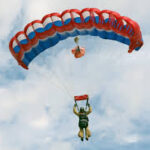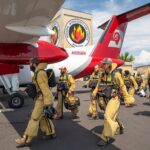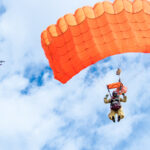
WINTHROP, Okanogan County — Somewhere deep in the North Cascades, lightning strikes a parched mountainside, igniting a wildfire.
Someone spots the blaze and calls emergency services. The tip gets routed to a U.S. Forest Service dispatcher in East Wenatchee, and fire managers have a decision to make: Would it take hours, if not days, for wildland firefighters to reach the blaze on foot?
If the answer is yes, it’s time to call in the smokejumpers.
Smokejumpers are an elite group of wildland firefighters trained to parachute out of planes and into remote areas to fight blazes. The hope is that if they can quickly stop the fire at its source, they’ll prevent its spread. With roughly 400 smokejumpers across nine bases in the Western U.S., this small group of specialists is the federal wildland firefighting force’s equivalent of the military’s special forces units.

Nestled amid the outdoor beauty of Washington’s Methow Valley sits the renowned North Cascades Smokejumper Base. Although it’s one of the smaller smokejumper bases, a posting there is among the more coveted because it’s considered the birthplace of this daring wildfire fighting technique.
As the Pacific Northwest braces for a potentially above-normal wildfire season, the base’s 30-strong crew plays an outsize role in the region’s response — a small but critical wildland firefighting tool that happens outside the public eye. In an average year, North Cascades smokejumpers respond to 45 fires. If they successfully put out these small fires before they become the next Bolt Creek or Cub Creek 2, you’ll never hear about their dozens of deployments over summer and fall.

Smokejumping may date to another era, but this hands-on skill remains relevant today amid changing fire behavior, even as modern technology — like satellites and drones — enters the wildland firefighting equation. There is no substitute for a human eye in an isolated backcountry setting, and smokejumpers are among the most precise tools in the precious hours after an initial spark.

So, you want to be a smokejumper?
In 1939, Auburn-born Francis Lufkin had several seasons under his belt as a Forest Service smoke chaser, the former name for wildland firefighters. That autumn, the Forest Service began an experimental parachute program at the airstrip now home to the Methow Valley State Airport.
The surrounding mountainous terrain held a variety of vegetation from sage to bitterbrush, making the North Cascades an ideal testing ground for this newfangled idea. At first assigned to climb trees and untangle stuck parachutes, Lufkin was eventually recruited to jump.
The program became an officially sanctioned arm of the U.S. Forest Service in 1944, and Lufkin served as the North Cascades Smokejumper Base’s first manager until his retirement in 1972. Today, his name graces the arched red building that’s home to the Lufkin Parachute Loft, with a plaque out front commemorating the historic experiment that occurred here. The base is a stop on the Methow Valley tourist circuit, and if the smokejumpers aren’t too busy, they even give tours.
The loft was a hive of activity on a sunny but windy day in June, as seven male recruits in their 20s and early 30s neared the end of a grueling six-week training program. At long trapezoidal tables, an instructor taught them to properly inspect their parachutes before a practice jump.
Given the risks of parachuting, smokejumpers undergo rigorous preparation. The base’s grounds include a 60-foot zip line tower that recruits jump out of hundreds of times to simulate parachuting before they ever leap out of an airplane.

The history of smokejumping is punctuated by a handful of tragedies, most notably the 1949 Mann Gulch fire in Montana that killed 12 jumpers. North Cascades Smokejumper Base suffered its worst loss in 1958 when a low-flying plane delivering cargo to smokejumpers on the ground crashed into a ridge, killing four.
Modern safety protocols limit the risk of injury largely to bumps and bruises, but rare fatal accidents still happen. West Yellowstone, Mont.-based smokejumper Tim Hart suffered a hard landing in May 2021 while parachuting into a New Mexico fire and later died from his injuries. In 2013, veteran Bureau of Land Management smokejumper Mark Urban died during a training exercise in Idaho when his parachute malfunctioned.
So how does one become a firefighter who jumps out of airplanes? The first prerequisite is serving on a handcrew, the most common organizational unit among the U.S. Forest Service’s 11,000-strong wildland firefighter force. Handcrews dig firelines — a stretch of dirt roughly the width of a hiking trail — to stop wildfires from spreading. If all burnable material on the ground has been removed, a fire should run out of fuel when it reaches a fireline.
The most skilled and physically fit handcrews are the Forest Service’s elite hotshot crews, who are more self-directed and tackle the toughest, hottest fires. Of the 100 hotshot crews nationwide, 12 are in Washington and Oregon. Serving on a hotshot crew is a strong résumé qualification for an aspiring smokejumper. So is experience in a helitack unit that deposits firefighters by helicopter and has them occasionally rappel into the blaze (as it turns out, jumping out of airplanes isn’t the only extreme way to reach a wildfire).
Smokejumping is open to men and women and requires a minimum of one year of wildland firefighting, though competitive candidates have three-plus years of experience. The physical requirements aren’t quite as demanding as military special forces, but smokejumper training is no walk in the park. On the morning of their June high winds practice jump, recruits pounded out pushups and situps in sets of 39 to honor the year of the North Cascades base’s founding. Two recruits had already washed out of the program — a 30% washout rate is typical.

“Something has already drawn us to the work,” said Sam Forstag, 29, a second-year rookie from Montana with 49 jumps to his name. “It’s a line of work that you want to be in or else you wouldn’t be digging trenches for 16 hours a day, 14 to 21 days in a row.”
Forstag worked four seasons on fire crews, including two as a squad leader, and applied to the smokejumper program twice before finally being selected. These days, he spends summer and fall parachuting into fires and lobbies the Montana Legislature for the ACLU during winter.
While parachuting in and hiking partway out of a fire sounds physically demanding, the alternative is even more so: “From the point I found out you could get paid to jump out of an airplane and parachute into a fire rather than hiking all the way in, it seemed like the most appealing piece of the profession we could be doing,” Forstag said.
The breathtaking landscapes are also a big draw.
“People who are doing this love the outdoors and like all the country you get to see,” Forstag said. “You get to see a lot more country from the sky. [The North Cascades] are some of the most beautiful jump country you could have.”
Last fire season, he parachuted into the Colville and Gifford Pinchot national forests as well as the Pasayten Wilderness.
Those attributes are part of what inspired 200 applicants nationwide to apply for a few dozen rookie spots before the current fire season. At its peak in the 1990s to early 2000s, the smokejumper program routinely saw 700-800 applicants per year.

An acute staffing shortage among the wildland firefighting force drew national attention last year, just as new benefits from the infrastructure law came into effect, like a temporary pay bump, additional mandated rest days between missions and a dedicated occupation classification in the federal civil service.
As a second-year smokejumper, Forstag now makes $17 per hour. If he didn’t have on-base housing — a mix of bunkhouses and FEMA trailers — keeping his North Cascades posting would be nigh impossible amid the Methow Valley’s housing crisis.
“A struggle a lot of folks deal with is paying for the cost of life and still being able to do this work,” Forstag said.

Jumping into the blaze
Later that June day, the recruits made their 27th practice jump, battling high winds to nail a target in a hay field a few miles away. (They have a ways to go to catch Dale Longanecker, who sits atop the base’s leaderboard with an all-time record of 896 jumps.)
A neighboring whiteboard listed the names of smokejumpers on call, and the loft had a firehouse feel as they milled about in T-shirts, boots and fire-resistant Nomex pants that allow for a quick transition if the base’s air raid siren goes off, signaling a fire response.
When the siren blares, smokejumpers race to a rack running the length of the building with jumpsuits at the ready. The suits are a weave of puncture-proof Kevlar and Nomex, and they’re made upstairs in a workspace laden with sewing machines and fabric bolts.
With just 400 smokejumpers nationwide, this unique garment is too bespoke for a contractor to produce, so the crews cut and sew their own. They cobble together the rest of their protective kit — knee pads, face mask — from an amalgam of sports.
“It’s a cross of motorcycle gear, hockey equipment, a homemade jumpsuit and a ski helmet,” said base manager Charles McCarthy, who has more than 400 jumps to his name. \
Within five minutes, the crew suits up in 85 pounds of gear and boards a waiting turboprop plane. The team consists of eight smokejumpers and two spotters. Two pilots fly the CASA C-212 Aviocar airplane, which is popular with parachuters for its retractable rear ramp.
Wearing flight suits and harnesses, spotters occupy front-facing seats in the cramped cabin while the jumpers face each other in two rows lining the body of the plane. The spotters command the mission and determine the jump site, looking for a meadow or clearing with at least a 50-foot radius that steers clear of hazardous trees. They relay information to ground control in Winthrop and dispatch in East Wenatchee and help pilots guide the aircraft into position for the jump.

“You’re at the mercy of the wind,” McCarthy said. “There’s no power to these parachutes.”
When it’s time to jump, the plane slows and flies 3,000 feet above ground level. The jumpers-in-command go first and radio back a report on ground conditions. If additional firefighters are requested, pairs of smokejumpers parachute in two-minute intervals — about the amount of time it takes for previous jumpers to land. Once everyone is on the ground, the pilots release a box of cargo that also descends via parachute.

The cargo contains everything the firefighters need to put out the blaze and survive in the backcountry: chain saw; tree climbing equipment; portable pump and hose; 7.5 gallons of water for every two people; food rations like canned soup and beef jerky; and sleeping bags and tools, including the wildland firefighter’s special: a Pulaski ax.
When it comes time to put out the fire, firefighters dig fire lines to cordon off the blaze and till the soil to starve the fire of fuel, so it dies naturally.
“Like you’re gardening: Turn over the wet dirt and mix it in,” McCarthy said.
The crew typically spends the night on-site and hand-turns the embers come morning to ensure they’re cold. Once the fire is confirmed dead, they load up 110 pounds of gear each and hike to the nearest ridgetop for helicopter extraction. Before the advent of the chopper, the end of a mission entailed hiking miles out of the deep backcountry with heavy gear or waiting for a pack horse.
Missions usually mean at least 24 hours away from civilization, and a stop for a burger is de rigueur on the way back to the base.
In mid-June, seven newly minted smokejumpers graduated from the North Cascades training with 30 practice jumps. Days later, several rookies were deployed to assist with firefighting in British Columbia, one source of smoke plaguing the U.S. By early July, North Cascades smokejumpers had made 34 jumps to staff six fires ignited by lightning strikes along the Cascade crest.

In a summer during which wildfire smoke has already blanketed large swaths of the U.S., the work performed by this small but uniquely skilled band of firefighters is more important than ever, and their ability to reach remote fires quickly is invaluable.
“For every minute the fire grows, the fewer the options we have,” said USFS Forest Fire Staff Officer Kyle Cannon, who is based at the East Wenatchee dispatch. “As a fire manager, it’s comforting to know the jumpers are up in the air.”
Gregory Scruggs: gscruggs@seattletimes.com; Gregory Scruggs is the outdoors reporter at The Seattle Times.
SOURCE: https://www.seattletimes.com/life/outdoors/meet-the-small-elite-north-cascades-firefighting-unit-that-parachutes-out-of-planes-to-fight-wildfires/






